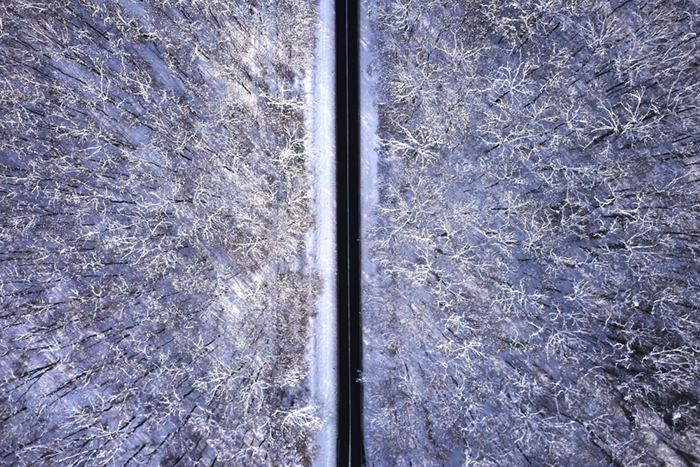The Evils of Roads — A Review of Ben Goldfarb’s Crossings

Few among us spend much time thinking through the implications of roads. Sure, we plan trips to avoid traffic, we dodge poorly maintained tarmac, and we might even seek out the finest views. And sure, we know that our cars kill wildlife and that roads themselves carve up habitat. We have even read of roads opening up once wild regions to logging, mining, and cattle ranching. We realize that roads harm nature, and we do not love that realization, but roads, for almost all of us, are first and foremost a means to an end, a path from point A to point B.
“Like most people,” writes Ben Goldfarb in Crossings, “I at once cherish animals and think nothing of piloting a three-thousand pound death machine.” After all, he points out, if we Americans love driving so much that we accept 40,000 human traffic fatalities every year, how much sleep will we lose over road kill?
But in fact he does lose more than a little sleep over both the direct and indirect road-related deaths of animals. He searches for knowledge about the magnitude of the problem at hand, the potential solutions and partial solutions that have been put in place, and the future of road design in a world increasingly concerned about animal welfare and animal rights. The search takes him across the United States and onward to parts of Australia, Europe, and Brazil. It guides him through scientific papers and historical accounts. And it pairs him with experts, often in their own vehicles, their own death machines.
Crossings presents a great deal—a very great deal—of information about nature, roads, and people. Like all books of its kind, it can hardly be called a page turner, yet like the best books of its kind every page, every paragraph, and almost every sentence adds something new.
Examples? How about numbers, including what Goldfarb calls “squishing statistics.” On a Lake Erie causeway, 28,000 leopard frogs were killed in just four years. Ten thousand garter snakes died on Manitoba roads in a single season. A country road in France accounted for 2,500 dead toads. In New York state, a car collides with a deer every eight minutes. In Australia, half a million joeys—that is, baby marsupials—are orphaned every year in vehicle accidents.
But Crossings is never just about the numbers. The numbers lead elsewhere. In the case of those half million joeys, they lead to carers. “Animal-loving Aussies,” writes Goldfarb, “have thus been trained to check the pouches of fresh roadkill, extract living joeys, and deliver them to one of the country’s fifteen thousand rehabbers, known as carers.” With that as a starting point, Goldfarb takes readers into the lives of Fable, who happens to be a wombat, and Cory Young, who is Fable’s carer. Cory and his partner raised forty-three animals in the year before they met Goldfarb, a year which, they said, was meant to be a break.
It turns out, perhaps not surprisingly, that carers need breaks. They suffer from compassion fatigue, ground down by the daily chores of raising animals and by the lack of empathy that prevails among the majority of Australians.
The existence of carers is not the only good news uncovered by Goldfarb’s search. Far from it. Although we live in an era of ever-increasing roads, we also live in times when roadbuilders—at least some of them—think beyond the need to enable rapid transport. Take Brazil, where one ecologist estimates that cars kill more than four hundred million animals each year and where roads continue to be built into ecosystems dominated by jungle and wetlands. But also take Brazil as exemplary in its efforts to minimize the damage caused by the roads that its citizens demand. “No tropical country is home to as many road ecologists,” Goldfarb writes, “and projects spring up constantly: underpasses for pumas and tapirs, a new bridge for a resplendently furred monkey called the lion tamarin.” Further incentivizing Brazil’s road designers are laws requiring highway operators to deliver injured animals to veterinarians and to compensate drivers for damage caused by collisions with animals. An end result: at least one Brazilian highway intentionally built with sharp curves designed to slow vehicles way down, and in so doing to give wildlife a chance. “We were prevented from speeding not only by law,” writes Goldfarb, “but by design.”
In the end, where are readers left? Roads are, by no stretch of the imagination, good for wildlife. “To us,” Goldfarb writes, “roads signify connection and escape; to other life forms, they spell death and division.” This book does nothing to expunge the collective guilt of all who depend on roads, which is, to one degree or another, all of us. But it does offer two insights that may move all of us toward a better world. In the first, we recognize that we have a momentous problem. And in the second, while we see that nothing close to an ideal solution is in the works, we also understand that humanity is taking at least taking a few small and scattered baby steps toward becoming a better species.


